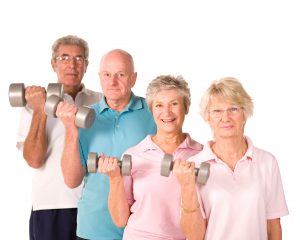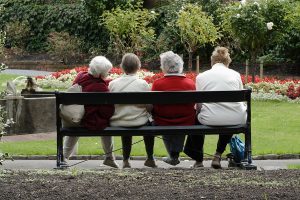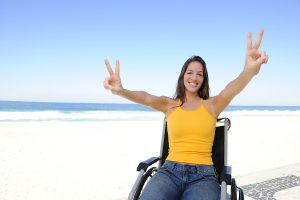Four Most Effective Ways to Treat Bone Spurs
Bone spurs, which are small projections that develop on the edges of bones, are a highly common ailment that affects about 2 percent of the U.S. population.
People of any age can develop bone spurs, but they’re especially common in senior citizens since they are often associated with osteoarthritis-related joint damage.
Bone spurs don’t always require medical treatment, but, depending on their location, they can contribute to joint inflammation, pain, and stiffness that limit mobility. Bone spurs along the spine are particularly problematic, as are ones that develop in the knee or ankle joints.
For seniors who are struggling with bone spurs, there are lots of different treatment options available, including the four listed below.
1. Weight Loss
Weight loss is one of the most effective treatments for managing bone spurs, especially spinal bone spurs.
Changing your diet will is, generally speaking, the most effective weight loss tool. Focus on limiting your caloric intake and cutting out greasy fast food and highly processed snacks. Replace them with high-quality protein, fruits, vegetables, and healthy fats like avocados and olive oil.
Foods rich in omega-3 fatty acids can also help lubricate the joints and relieve inflammation.
2. Lifestyle Aids
There are lots of tools out there as well that can help relieve pain caused by bone spurs. Some good options to invest in include:
Supportive shoes that cushion the feet and avoid putting extra strain on the joints
Orthotic inserts to provide extra support
A shoe horn to help you avoid bending over and aggravating your back while getting dressed
3. Regular Exercise
Exercise releases natural painkillers in the form of endorphins. It also strengthens the muscles to help support the joints and relieve pressure placed on them.
Resistance training, walking, and swimming are all good exercise options for people struggling with bone spurs. Work with a trainer or physical therapist to make sure you’re practicing proper form and not doing anything to aggravate your condition.
4. Minimally Invasive Surgery
Finally, some people require minimally invasive surgery to get rid of their bone spurs. When you undergo surgery, a doctor will use state-of-the-art equipment to identify the spur and extract it.
This is typically an outpatient procedure, and the recovery time only lasts a few hours — you’ll be up and walking shortly after and won’t have to deal with an extended hospital stay.
Guest Blog: How to Make a Difference in the Lives of Seniors in Your Community
From the loneliness and isolation that many seniors face to the physical impairments or disabilities that may limit their ability to perform some daily tasks on their own, many aging adults could benefit from the assistance of other members in their community. If you’re interested in helping seniors living in your neighborhood, the following resources will familiarize you with the different challenges that many aging adults face, as well as some of the things you can do to help out.
The Challenges of Growing Older
There is a saying that growing older is not for sissies, and in a sense that is very true. It stems, of course, from the fact that the strength and vibrance of our bodies and minds can wane over the years. Being aware of the challenges older people face can help you recognize opportunities and define your responses to them.
- Explore this comprehensive guide to issues facing seniors
- Seniors who are growing older without partners or family close by face unique struggles
- Growing older means coming to grips with one’s mortality; be sensitive to the spiritual needs seniors experience
- Among their challenges, basic needs like performing household tasks and meal preparation can be difficult for seniors
- Falling is a major health concern for seniors, even in their own homes
What You Can Do to Help
Sometimes finding opportunities isn’t the hardest part of assisting seniors; sometimes it’s finding practical solutions. Seniors face problems big and small that you can solve, though. Thankfully, most of those solutions are surprisingly straightforward, and really just require a little bit of thinking outside the box. Explore these simple strategies for some of the concerns you might realize are part of an older adult’s life.
- Isolation is a common health issue for seniors but there are practical solutions
- Being homebound is an issue for many seniors
- Teaching technology to seniors is a great way to connect them with others and help them feel engaged, even if they are homebound
- An Echo Dot is an affordable device for seniors that allows them to perform a variety of practical tasks
- Most seniors can get comfortable with smart speakers like Alexa pretty quickly with a few pointers, and they reap many benefits
- Taking quick, easy and healthy meals to seniors helps to ensure they receive proper nutrition
- Another idea is to set up a senior with grocery delivery for fresh meals
- Senior Care Central offers individualized care solutions for seniors
If your family is interested in giving back to seniors in your community, this guide will help you to get started. By sharing your time, helping a senior neighbor with housework, and cooking meals for aging adults in your community, you’ll be making a difference in the lives of local seniors.
Guest Blog: 5 Ways to Deal with Weight Gain

Putting on a bit of weight – a pound or two – each year as you grow older is fairly normal, but weight gain is not always inevitable. Many people simply assume that everyone gains a little weight as they get older. They tend to accept it as a part of growing old. You don’t have to do that.
We do put on weight as we age because we become more sedentary, move around less frequently, and eat more calories even when our metabolism has begun to slow down. But, there are ways to deal with weight gain.
Here in this post, we will discuss the top five ways to deal with weight gain as you grow older. Read on.
1. More Physical Activity
To prevent weight gain, it is important to add regular movement to your day. This is the MOST important advice that you shouldn’t ignore at any cost.
You can go on morning/evening walks more often, take the stairs at work, or hit the gym a few times each week.
You need to move around.
The chief reason why we lose muscle mass as we grow old, which in turn lowers metabolism, is that we spend too much time without any physical movement. After the age of 40, we lose around 8% of lean muscle mass with each passing decade.
When you are physically active, it will be much easier to preserve muscle mass and maintain a healthy metabolic rate. Activities such as regular exercise, lifting weights, etc. will also increase bone density. You can also try doing yoga at home or at a local fitness training center.
Remember, every little bit counts when you are dealing with weight gain.
If you are on medication, have an existing health condition or are recovering from an injury, be sure to speak with your doctor before you start with a new exercise routine.
2. Get More Protein
Taking more protein at each meal/snack not only helps in building and repairing muscle mass, but it also helps control the appetite.
The best way to use protein-rich foods to reverse the weight-gain cycle is to choose the leanest sources. You need to eat foods that are high in protein but low in fats.
Some of the leanest sources include non-fat dairy products, seafood, egg white, poultry breast, lean pieces of red meat, beans, tofu, lentils, etc.
Your high-protein breakfast for weight management can include skim-milk with some lean sources such as low-fat yogurt and an egg.
Your high-protein lunch/dinner for weight management can include 2-3 ounces of lean meat. You can have some skim milk during lunch and dinner as well.
3. Watch What You Eat
Bid adieu to foods (e.g. junk food) and drinks (e.g. soda) that provide little or no nutrient value.
Limit your carbohydrate intake as much as possible.
You can limit both the size and the type of carbohydrate you are consuming on a daily basis.
Carbs from whole gain, for instance, can be helpful in dealing with weight gain.
Each time you are hungry, try to eat something that’s low on calories and makes you feel fuller.
Many vegetables and whole fruits, for instance, provide a wide range of nutrients (along with fiber and water) for a comparatively small number of calories.
4. Be Realistic
As you grow older, you will need more time to lose weight. Someone 10 years younger than you can deal with weight gain more easily.
So, you must focus on the process instead of getting worried about weight gain. You need to eat right and keep yourself physically active. Your body will respond to these two major lifestyle changes in its own time.
5. Maintain a Diary
Do not let yourself believe that you cannot stop gaining weight simply because you are getting older.
You can keep a daily journal to keep yourself motivated. You can write things like – how much weight you lost or gained in a week, how much time you spent exercising/strength-training, and how much water/healthy-drinks you consumed each week.
You can monitor the progress you are making each week.
This way, it is easier to stay the course.
Author Bio
Sarah Remmington is one of the founders of Garcinia Cambogia 100 Pure supplements based out of Southern California with several other locations throughout the US. Sarah’s company has become a global brand and now a household name with the success of her most popular dietary supplement which has been featured on many different media channels.
Seniors: How to Cope and Manage Hearing Loss
Hearing loss is a disability that affects over 36 million American adults; 30 percent of those afflicted are 65-74 years old and 47 percent are 75 or older.
The Hearing Loss Association of America cites three types of hearing loss:
1. Conductive hearing loss is due to ear canal, ear drum, or middle ear problems. Most causes of conductive hearing loss can be treated with surgery or hearing aids, particularly bone conductive hearing aids.
2. Censorial hearing loss (nerve-related hearing loss) is due to inner ear problems. Depending upon the cause, treatments include medications or, in some cases, surgery.
3. Mixed hearing loss is when there is damage in the outer or middle ear as well as the inner ear or auditory nerve. The conductive hearing loss is usually treated first, then the censorial.
Hearing loss can have a profound impact on our work and social interactions. People with this disability may experience depression and as a result, anger at others or withdrawal from occasions where their hearing loss will be noticeable. Unfortunately, there is no cure to hearing loss, although, there are effective ways to manage it and be proactive. Learn about your disability and seek assistance to help cope.
- Hearing aids –Purchase your hearing aids from an auditory or medical professional who specializes in hearing, not someone who specializes in selling hearing aids. Hearing Denial suggests booking with ones that are able to offer evaluations and custom hearing aid fittings all within one supplier.
- Cochlear implants – You will need an evaluation by an audiologist and an implant-affiliated physician to determine if you are eligible for cochlear implants.
- Hearing Assistive Technology is available at most performing arts venues, including most movie theaters. Amplified and captioned phone systems, smoke detectors and doorbells are also available.
Responding to Others
Communication is still a two-way. There are ways you can help maintain your end of communication with others. Some suggestions include:
- Do your best to focus and concentrate.
- Admit it when you don’t understand.
- Watch for visual clues and ask for written clues if necessary.
- Maintain your sense of humor and positive attitude.
Guest Blog: What are the main differences between Wheelchairs and Medical Scooters?
One wonders what life would be like if they lost the ability to move and walk around freely, especially if they have come of age already. But the real thing they do not ask themselves are the different options to choose from if such a situation like that comes upon them.
There is an option such as a wheelchair. It is basically a chair that is fitted for a person who has lost the ability to walk normally due to an injury, illness, or disability. Another option is the medical scooter which is designed to look like more of a scooter with the handles in the front of the user and is used by people who still have some ability to use their legs.
There are many differences between a wheelchair and a medical scooter. Here are some of those:
1. Type of Operation
One main difference would be how the two are operated by the handler. With a wheelchair, it can be done by another person behind the wheelchair holding onto the handles and pushing it forward. Another way to use it is by the person in the wheelchair putting their hands on the wheels and pushing them forward which moves them.
The medical scooter, on the other hand, is operated by the person using it putting their hands on the handlebars in front of them and using electricity to power to scooter to move where they want it to go.
2. Design
Another difference is the design of each of them. Wheelchairs usually have two big wheels in back and two small wheels in front to balance the user while the medical scooters can have four wheels with two in front and two in the back. It could also be three wheels with two in the back and one in the front center.
3. Cost
Another huge difference that can affect the users or family is the cost for each of the options. For a typical average wheelchair, the cost can be between $1,000 to $2,000 while the medical scooters the cost can be between $800 to $3,000 or even more depending on the size and model of the scooter.
Which one should you choose?
When it comes to deciding between a wheelchair or a medical scooter, it all depends on the needs of the user. Like the length of time the user will be sitting or the speed they desire or even the design. In the end, the final say should be based on the comfort-ability these mobile aids give to the disabled people or the elderly.




